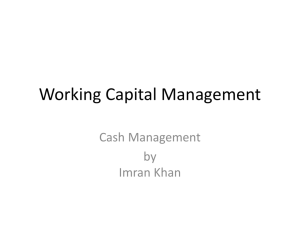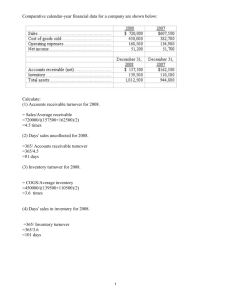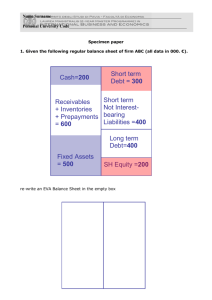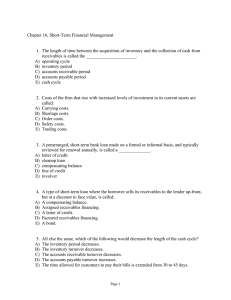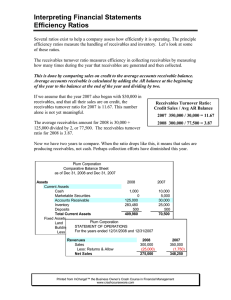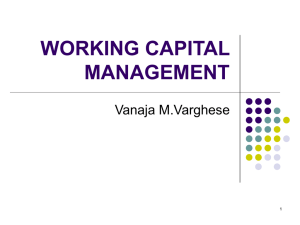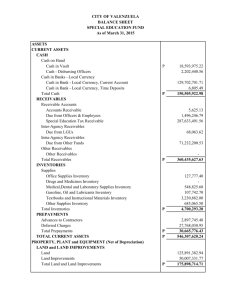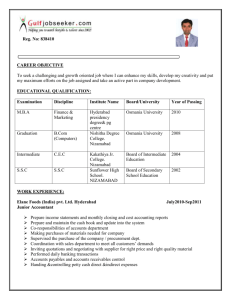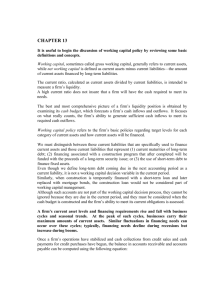Chapter 16 Answers to Concepts Review and Critical Thinking Questions 1.
advertisement
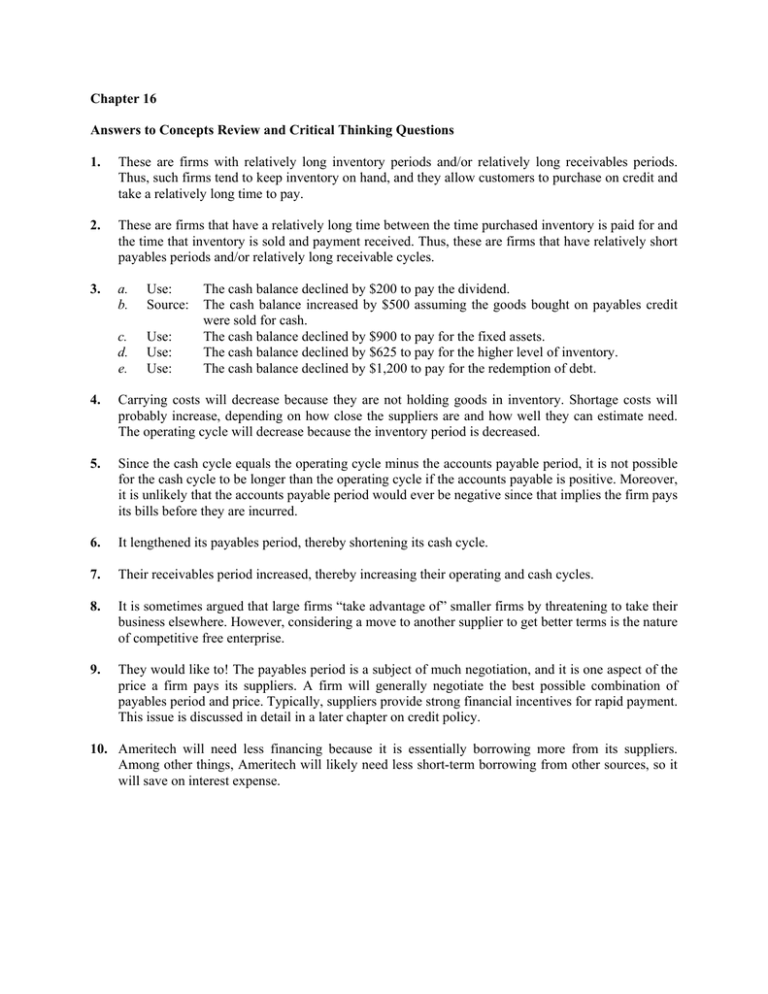
Chapter 16
Answers to Concepts Review and Critical Thinking Questions
1.
These are firms with relatively long inventory periods and/or relatively long receivables periods.
Thus, such firms tend to keep inventory on hand, and they allow customers to purchase on credit and
take a relatively long time to pay.
2.
These are firms that have a relatively long time between the time purchased inventory is paid for and
the time that inventory is sold and payment received. Thus, these are firms that have relatively short
payables periods and/or relatively long receivable cycles.
3.
a.
b.
Use:
Source:
c.
d.
e.
Use:
Use:
Use:
The cash balance declined by $200 to pay the dividend.
The cash balance increased by $500 assuming the goods bought on payables credit
were sold for cash.
The cash balance declined by $900 to pay for the fixed assets.
The cash balance declined by $625 to pay for the higher level of inventory.
The cash balance declined by $1,200 to pay for the redemption of debt.
4.
Carrying costs will decrease because they are not holding goods in inventory. Shortage costs will
probably increase, depending on how close the suppliers are and how well they can estimate need.
The operating cycle will decrease because the inventory period is decreased.
5.
Since the cash cycle equals the operating cycle minus the accounts payable period, it is not possible
for the cash cycle to be longer than the operating cycle if the accounts payable is positive. Moreover,
it is unlikely that the accounts payable period would ever be negative since that implies the firm pays
its bills before they are incurred.
6.
It lengthened its payables period, thereby shortening its cash cycle.
7.
Their receivables period increased, thereby increasing their operating and cash cycles.
8.
It is sometimes argued that large firms “take advantage of” smaller firms by threatening to take their
business elsewhere. However, considering a move to another supplier to get better terms is the nature
of competitive free enterprise.
9.
They would like to! The payables period is a subject of much negotiation, and it is one aspect of the
price a firm pays its suppliers. A firm will generally negotiate the best possible combination of
payables period and price. Typically, suppliers provide strong financial incentives for rapid payment.
This issue is discussed in detail in a later chapter on credit policy.
10. Ameritech will need less financing because it is essentially borrowing more from its suppliers.
Among other things, Ameritech will likely need less short-term borrowing from other sources, so it
will save on interest expense.
Solutions to Questions and Problems
NOTE: All end-of-chapter problems were solved using a spreadsheet. Many problems require multiple
steps. Due to space and readability constraints, when these intermediate steps are included in this
solutions manual, rounding may appear to have occurred. However, the final answer for each problem is
found without rounding during any step in the problem.
Basic
1.
a.
No change. A dividend paid for by the sale of debt will not change cash since the cash raised
from the debt offer goes immediately to shareholders.
b.
No change. The real estate is paid for by the cash raised from the debt, so this will not change
the cash balance.
c.
No change. Inventory and accounts payable will increase, but neither will impact the cash
account.
d.
Decrease. The short-term bank loan is repaid with cash, which will reduce the cash balance.
e.
Decrease. The payment of taxes is a cash transaction.
f.
Decrease. The preferred stock will be repurchased with cash.
g.
No change. Accounts receivable will increase, but cash will not increase until the sales are paid
off.
h.
Decrease. The interest is paid with cash, which will reduce the cash balance.
i.
Increase. When payments for previous sales, or accounts receivable, are paid off, the cash
balance increases since the payment must be made in cash.
j.
Decrease. The accounts payable are reduced through cash payments to suppliers.
k.
Decrease. Here, the dividend payments are made with cash, which is generally the case. This is
different from part a, where debt was raised to make the dividend payment.
l.
No change. The short-term note will not change the cash balance.
m.
Decrease. The utility bills must be paid in cash.
n.
Decrease. A cash payment will reduce cash.
o.
Increase. If marketable securities are sold, the company will receive cash from the sale.
2.
The total liabilities and equity of the company are the net book worth, or market value of equity, plus
the long-term debt, so:
Total liabilities and equity = $38,000 + 6,500
Total liabilities and equity = $44,500
This is also equal to the total assets of the company. Since total assets are the sum of all assets, and
cash is an asset, the cash account must be equal to total assets minus all other assets, so:
Cash = $44,500 – 32,500 – 4,300
Cash = $7,700
We have NWC other than cash, so the total NWC is:
NWC = $4,300 + 7,700
NWC = $12,000
We can find total current assets by using the NWC equation. NWC is equal to:
NWC = CA – CL
$12,000 = CA – $7,200
CA = $19,200
3.
4.
a.
Increase. If receivables go up, the time to collect the receivables would increase, which
increases the operating cycle.
b.
Increase. If credit repayment times are increased, customers will take longer to pay their bills,
which will lead to an increase in the operating cycle.
c.
Decrease. If the inventory turnover increases, the inventory period decreases.
d.
No change. The accounts payable period is part of the cash cycle, not the operating cycle.
e.
Decrease. If the receivables turnover increases, the receivables period decreases.
f.
No change. Payments to suppliers affects the accounts payable period, which is part of the cash
cycle, not the operating cycle.
a.
Increase; Increase. If the terms of the cash discount are made less favorable to customers, the
accounts receivable period will lengthen. This will increase both the cash cycle and the
operating cycle.
b.
Increase; No change. This will shorten the accounts payable period, which will increase the
cash cycle. It will have no effect on the operating cycle since the accounts payable period is not
part of the operating cycle.
5.
c.
Decrease; Decrease. If more customers pay in cash, the accounts receivable period will
decrease. This will decrease both the cash cycle and the operating cycle.
d.
Decrease; Decrease. Assume the accounts payable period and inventory period do not change.
Fewer raw materials purchased will reduce the inventory period, which will decrease both the
cash cycle and the operating cycle.
e.
Decrease; No change. If more raw materials are purchased on credit, the accounts payable
period will tend to increase, which would decrease the cash cycle. We should say that this may
not be the case. The accounts payable period is a decision made by the company’s
management. The company could increase the accounts payable account and still make the
payments in the same number of days. This would leave the accounts payable period
unchanged, which would leave the cash cycle unchanged. The change in credit purchases made
on credit will not affect the inventory period or the accounts payable period, so the operating
cycle will not change.
f.
Increase; Increase. If more goods are produced for inventory, the inventory period will
increase. This will increase both the cash cycle and operating cycle.
a.
45-day collection period implies all receivables outstanding from previous quarter are collected
in the current quarter, and (90-45)/90 = 1/2 of current sales are collected.
Beginning receivables
Sales
Cash collections
Ending receivables
b.
Q2
Q3
$300
490
(545)
$245
$245
610
(550)
$305
$305
780
(695)
$390
Q4
$390
830
(805)
$415
60-day collection period implies all receivables outstanding from previous quarter are collected
in the current quarter, and (90-60)/90 = 1/3 of current sales are collected.
Beginning receivables
Sales
Cash collections
Ending receivables
c.
Q1
Q1
Q2
Q3
$300
490
(463)
$327
$327
610
(530)
$407
$407
780
(667)
$520
Q4
$520
830
(797)
$553
30-day collection period implies all receivables outstanding from previous quarter are collected
in the current quarter, and (90-30)/90 = 2/3 of current sales are collected.
Beginning receivables
Sales
Cash collections
Ending receivables
Q1
Q2
Q3
$300
490
(627)
$163
$163
610
(570)
$203
$203
780
(723)
$260
Q4
$260
830
(813)
$277
6.
The operating cycle is the inventory period plus the receivables period. The inventory turnover and
inventory period are:
Inventory turnover = COGS/Average inventory
Inventory turnover = $41,654/{[$6,118 + 7,302]/2}
Inventory turnover = 6.2077 times
Inventory period = 365 days/Inventory turnover
Inventory period = 365 days/6.2077
Inventory period = 58.80 days
And the receivables turnover and receivables period are:
Receivables turnover = Credit sales/Average receivables
Receivables turnover = $65,351/{[$3,764 + 4,483]/2}
Receivables turnover = 15.8484 times
Receivables period = 365 days/Receivables turnover
Receivables period = 365 days/15.8484
Receivables period = 23.03 days
So, the operating cycle is:
Operating cycle = 58.80 days + 23.03 days
Operating cycle = 81.83 days
The cash cycle is the operating cycle minus the payables period. The payables turnover and payables
period are:
Payables turnover = COGS/Average payables
Payables turnover = $41,654/{[$4,986 + 5,327]/2}
Payables turnover = 8.0780 times
Payables period = 365 days/Payables turnover
Payables period = 365 days/8.0780
Payables period = 45.18 days
So, the cash cycle is:
Cash cycle = 81.83 days – 45.18 days
Cash cycle = 36.64 days
The firm is receiving cash on average 36.64 days after it pays its bills.
7.
If we factor immediately, we receive cash on an average of 34 days sooner. The number of periods in
a year are:
Number of periods = 365/46
Number of periods = 7.9348
The EAR of this arrangement is:
EAR = (1 + Periodic rate)m – 1
EAR = (1 + 1.5/98.5)7.9347 – 1
EAR = .1274 or 12.74%
8.
a.
The payables period is zero since the company pays immediately. The payment in each period
is 30 percent of next period’s sales, so:
Q1
Payment of accounts
b.
$195.00
$237.00
Q3
$252.50
Q4
$238.05
Since the payables period is 90 days, the payment in each period is 30 percent of the current
period sales, so:
Q1
Payment of accounts
c.
Q2
$207.00
Q2
$195.00
Q3
$237.00
Q4
$252.00
Since the payables period is 60 days, the payment in each period is 2/3 of last quarter’s orders,
plus 1/3 of this quarter’s orders, or:
Quarterly payments = 2/3(.30) times current sales + 1/3(.30) next period sales.
Payment of accounts
9.
Q1
Q2
Q3
Q4
$203.00
$209.00
$242.00
$247.35
Since the payables period is 60 days, payables in each period = 2/3 of last quarter’s orders, and 1/3
of this quarter’s orders, or 2/3(.75) times current sales + 1/3(.75) next period sales.
Q1
Payment of accounts
Wages, taxes, other expenses
Long-term financing expenses
(interest and dividends)
Total
Q2
Q3
Q4
$560.00
210.00
30.00
$615.00
$617.50
$715.00
252.00
234.00
273.00
30.00 30.00 30.00
$800.00
$897.00
$881.50
$1,018.00
10. a.
The November sales must have been the total uncollected sales minus the uncollected sales
from December, divided by the collection rate two months after the sale, so:
November sales = ($68,000 – 49,000)/0.15
November sales = $126,666.67
b.
The December sales are the uncollected sales from December divided by the collection rate of
the previous months’ sales, so:
December sales = $49,000/0.35
December sales = $140,000.00
c.
The collections each month for this company are:
Collections = .15(Sales from 2 months ago) + .20(Last months sales) + .65 (Current sales)
January collections = .15($126,666.67) + .20($140,000) + .65($138,000)
January collections = $136,700.00
February collections = .15($140,000) + .20($138,000) + .65($165,000)
February collections = $155,850.00
March collections = .15($138,000) + .20($165,000) + .65($195,000)
March collections = $180,450.00
11. The sales collections each month will be:
Sales collections = .35(current month sales) + .60(previous month sales)
Given this collection, the cash budget will be:
Beginning cash balance
Cash receipts
Cash collections from
credit sales
Total cash available
Cash disbursements
Purchases
Wages, taxes, and expenses
Interest
Equipment purchases
Total cash disbursements
Ending cash balance
April
$185,000
May
$243,000
June
$270,500
382,000
$567,000
393,500
$636,500
400,500
$671,000
$190,000
94,000
10,000
30,000
324,000
$243,000
$185,000
$210,000
86,000
10,000
60,000
366,000
$270,500
$243,000
$185,000
105,000
10,000
190,000
490,000
$181,000
$270,500
12. a.
45-day collection period implies all receivables outstanding from previous quarter are collected
in the current quarter, and (90-45)/90 = 1/2 of current sales are collected.
Q1
Beginning receivables
Sales
Cash collections
Ending receivables
b.
$2,200
4,900
(4,650)
$2,450
Q3
$2,450
5,700
(5,300)
$2,850
$2,850
5,100
(5,400)
$2,550
Q4
$2,550
6,400
(5,750)
$3,200
60-day collection period implies all receivables outstanding from previous quarter are collected
in the current quarter, and (90-60)/90 = 1/3 of current sales are collected.
Q1
Beginning receivables
Sales
Cash collections
Ending receivables
c.
Q2
$2,200
4,900
(3,833)
$3,267
Q2
Q3
$3,267
5,700
(5,167)
$3,800
$3,800
5,100
(5,500)
$3,400
Q4
$3,400
6,400
(5,533)
$4,267
30-day collection period implies all receivables outstanding from previous quarter are collected
in the current quarter, and (90-30)/90 = 2/3 of current sales are collected.
Q1
Beginning receivables
Sales
Cash collections
Ending receivables
$2,200
4,900
(5,467)
$1,633
Q2
Q3
$1,633
5,700
(5,433)
$1,900
$1,900
5,100
(5,300)
$1,700
Q4
$1,700
6,400
(5,967)
$2,133
13. If we factor immediately, we receive cash on an average of 28 days sooner. The number of periods in
a year are:
Number of periods = 365/28
Number of periods = 13.0357
The EAR of this arrangement is:
EAR = (1 + Periodic rate)m – 1
EAR = (1 + 2/98)13.0357 – 1
EAR = .3013 or 30.13%
14. Since the payables period is 40 days, payables in each period = 1/2 of last quarter’s orders, and 1/2
of this quarter’s orders, or 1/2(.60) times current sales + 1/2(.60) next period sales.
Q1
Payment of accounts
Wages, taxes, other expenses
Long-term financing expenses
(interest and dividends)
Total
Q2
Q3
$318.00
130.00
15.00
$342.00
$384.00
$429.00
135.00
150.00
170.00
15.00 15.00 15.00
$463.00
$492.00
$549.00
Intermediate
15. a.
If you borrow $70,000,000 for one month, you will pay interest of:
Interest = $70,000,000(.0048)
Interest = $336,000
However, with the compensating balance, you will only get the use of:
Amount received = $70,000,000 – 70,000,000(.05)
Amount received = $66,500,000
This means the periodic interest rate is:
Periodic interest = $336,000/$66,500,000
Periodic interest = .00505 or .505%
So, the EAR is:
EAR = [1 + ($336,000/$66,500,000)]12 – 1
EAR = .0623 or 6.23%
b.
To end up with $15,000,000, you must borrow:
Amount to borrow = $15,000,000/(1 – .05)
Amount to borrow = $15,789,473.68
The total interest you will pay on the loan is:
Total interest paid = $15,789,473.68(1.0048)6 – 15,789,473.68
Total interest paid = $460,228.73
16. a.
The EAR of your investment account is:
EAR = 1.0064 – 1
EAR = 2.42%
Q4
$614.00
b.
To calculate the EAR of the loan, we can divide the interest on the loan by the amount of the
loan. The interest on the loan includes the opportunity cost of the compensating balance. The
opportunity cost is the amount of the compensating balance times the potential interest rate you
could have earned. The compensating balance is only on the unused portion of the credit line,
so:
Opportunity cost = .06($60,000,000 – 40,000,000)(1.006)4 – .06($60,000,000 – 40,000,00)
Opportunity cost = $29,060.24
And the interest you will pay to the bank on the loan is:
Interest cost = $40,000,000(1.0124)4 – 40,000,000
Interest cost = $2,021,208.41
So, the EAR of the loan in the amount of $40,000,000 is:
EAR = ($2,021,208.41 + 29,060.24)/$40,000,000
EAR = .0513 or 5.13%
c.
The compensating balance is only applied to the unused portion of the credit line, so the EAR
of a loan on the full credit line is:
EAR = 1.01244 – 1
EAR = .0505 or 5.05%
17. Here, we need to use the cash cycle and operating cycles to calculate the average accounts payable
and average accounts receivable. We are given the cash cycle and the operating cycle, so the
payables period is:
Cash cycle = Operating cycle – Payables period
32 days = 49 days – Accounts payable period
Accounts payable period = 17 days
Now, we can use the payables period equation to find the accounts payable turnover, which is:
Payables period = 365 / Payables turnover
17 = 365 / Payables turnover
Payables turnover = 21.47 times
Now, we can solve the payables turnover equation to find the average payables:
Payables turnover = Cost of goods sold / Average payables
21.47 = $325,000 / Average payables
Average payables = $15,136.99
Next, we can find the average accounts receivable. Using the equation for the operating cycle, the
accounts payable period is:
Operating cycle = Inventory period + Receivables period
49 days = 27 days + Receivables period
Receivables period = 22 days
Using the receivables period equation, we find:
Receivables period = 365 / Receivables turnover
22 = 365 / Receivables turnover
Receivables turnover = 16.59 times
Finally, the average accounts receivable balance is:
Receivables turnover = Credit sales / Average accounts receivable
16.59 = $508,000 / Average accounts receivable
Average accounts receivable = $30,619.18
18. Since the company has a 40-day collection period, only those sales made in the first 50 days of the
quarter will be collected in that quarter. Total cash collections in the first quarter will be:
Q1 cash collections = Beginning receivables + (50/90)(Quarter 1 sales)
Q1 cash collections = $110 + (50/90)($210)
Q1 cash collections = $227
And cash collection in the second quarter will be sales made in the first 50 days of the quarter plus
sales made in the last 40 days of the first quarter, so:
Q2 cash collections = (50/90)(Quarter 2 sales) + (40/90)(Quarter 1 sales)
Q2 cash collections = (50/90)($280) + (40/90)($210)
Q2 cash collections = $249
Quarter 3 and Quarter 4 collections will be:
Q3 cash collections = (50/90)(Quarter 3 sales) + (40/90)(Quarter 2 sales)
Q3 cash collections = (50/90)($260) + (40/90)($280)
Q3 cash collections = $269
Q4 cash collections = (50/90)(Quarter 4 sales) + (40/90)(Quarter 3 sales)
Q4 cash collections = (50/90)($330) + (40/90)($260)
Q4 cash collections = $299
The beginning receivables in each quarter will be the sales made in the last 40 days of the previous
quarter, so:
Q2 beginning receivables = (40/90)(Quarter 1 sales)
Q2 beginning receivables = (40/90)($210)
Q2 beginning receivables = $93
Q3 beginning receivables = (40/90)(Quarter 2 sales)
Q3 beginning receivables = (40/90)($280)
Q3 beginning receivables = $124
Q4 beginning receivables = (40/90)(Quarter 3 sales)
Q4 beginning receivables = (40/90)($260)
Q4 beginning receivables = $116
The cash budget (in millions) for the company is:
Beginning receivables
Sales
Cash collections
Ending receivables
Total cash collections
Total cash disbursements
Net cash inflow
Beginning cash balance
Net cash inflow
Ending cash balance
Minimum cash balance
Cumulative surplus (deficit)
Q1
$110
210
227
$93
$227
190
$37
$10
37
$47
–$10
$37
Q2
$93
280
249
$124
$249
240
$9
$47
9
$56
–$10
$46
Q3
$124
260
269
$116
$269
350
–$81
$56
–81
–$26
–$10
–$36
Q4
$116
330
299
$147
$299
220
$79
–$26
79
$53
–$10
$43
The company has a cash surplus for much of the year, but in Quarter 3, it will need to raise $16
million to cover its cash flows.
